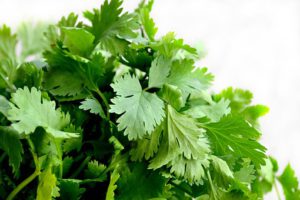
Thinking of growing cilantro hydroponically, then you have found the right article to show you how to grow cilantro along with a tip to make sure it is tasty.
Cilantro ( Coriandrum Sativum) is a leafy herb which will grow flowers and produce seed in times of stress.
All parts of the plant are edible, even the root, which some areas of Vietnam use in recipes.
The whole plant is also known in the UK as coriander, but this maybe incorrect as the leaf is cilantro and the seed is coriander.
You can grow Cilantro in your garden in warmer weather, wait till the soil has had the last frost, or you can grow it indoors.
When space is at a premium then it is worth growing it hydroponically to increase the yield
Cilantro
varieties
If you are looking to grow cilantro for leaf then go for varieties like Santo, long standing, Calypso or Marino. These are slow bolting varieties ideal for growing hydroponically. These can be harvested more than once before replacing.
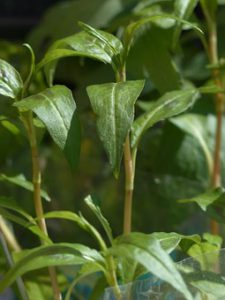
If you are looking to grow coriander seed, then all varieties are good, but especially cruiser and leisure.
Vietnamese corainder (Polygonum odoratum) may be a better choice in warmer weather to reduce bolting.
The leaves are narrow and smooth edged, unlike typical cilantro.
Culantro is another variant to try – called spiny coriander it is popular in Asian and Caribbean culture. Apparently it’s name means ‘ foul smellnig thistle’. Makes you want to eat it.
Seeds
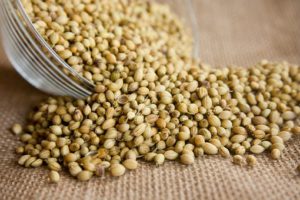
The round fruit you see as coriander seeds are really two seeds within a fruit.
So every time you plant one seed you are really planting two seeds.
The tough seeds can be presoaked to improve germination time.
Lay out a piece of kitchen paper and soak in water, lay out the seeds overnight.
They are ready to be planted.
Germination
The seeds will appear between 7 -10 days after planting.
The temperature they like is between 65- 70F ( 18-21C), so spring or autumn is a good time to plant.
They need moderate light levels to prevent
Plant the seeds in their final place as they do not like to be transplanted.
You can plant more seeds than normal as they will grow in a clump with no problems.
Keep the substrate moist but not too wet and never let it dry out completely – the plants will get stressed and run to seed.
Growing on
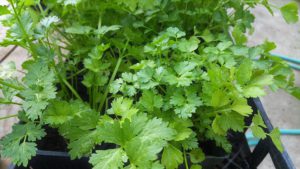
As stated above the seedlings do not like to be separated after starting to grow, it is the tap root which does not like to be disturbed.
So growing hydroponically, start them out in a small grow cube and then place that into a larger one. Rather than trying to remove the seedlings and replanting.
You can start harvesting the leaves after 5 weeks.
Watch out for bolting conditions and if you don’t want seeds remove any bolting stems.
Make sure you don’t starve your plants as this will stress them and cause them to bolt.
Harvesting
The leaves can be harvested as microgreens after a few weeks, as the plants have developed two to four leaves.
The main leaves can be harvested at about a 5 week period and again at an 8 week period, after which the crop is finished.
Once harvested use as soon as you can.
If there is going to be a delay between harvesting and using then place the stems in a glass of water or put in the fridge in a plastic bag to slow down the wilting due to respiration.
The leaves can be frozen to keep their flavor as drying them they tend to lose a lot of flavour.
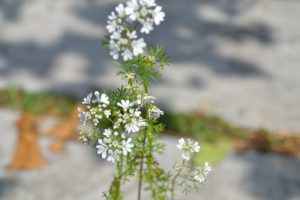
The flowers can be eaten and have a delicate flavour, they can be mixed into the salad or used as a garnish.
The leaves have a completely different flavour to the seeds and some say they taste like soap. So it is a bit like Marmite – you either like it or you don’t.
According to the university of Minnesota, herbs grown hydroponically have 20-40% more aromatic oils than field grown ones.
Nutrients
Since the plant is mostly vegetative then nutrients with a high nitrogen to phosphorus ratio are excellent choices.
Low to medium EC, nutrient strength, with a range of about 1.2- 1.8 is ideal.
The pH of the nutrient solution should be kept within 5.8 to 6.4, as with most other culinary herbs.
Step by step growing
step 1
Soak your medium and make sure to remove the excess water, you want it damp not soaking.
So with rockwool, you want to soak it and leave it to drain for a while.
With coco coir soak it and then squeeze it to get rid of most of the water.
Remember that Cilantro doesn’t like to be moved once growing so pick your container wisely
Place two or three seeds in the hole in rockwool and cover with a clear top to act as a green house
Step 2
Keep an eye on the seeds for germination.
Spray the medium to keep it damp – not wet.
Remove the covering when you see sprouts.
Grow on in a well lit area.
You may need a grow light to prevent them growing leggy.
Step 3
When they are about 50mm tall then place grow cubes into a hydroponic system.
Or if using coco coir setup in an ebb and flow system or drip system (preferable).
Ensure you use a lowish strength nutrient ( go with half to three quarters strength)
Have the light on for a minimum of 12 hours and if you can 24 hours.
Start the wind going gently to circulate air through the crop.
Step 4
Raise the light to keep it about 25mm above the plants.
Make sure the system never dries out.
Check daily for critters and bacterial leafspot, increase the wind if seen.
Step 5
When the crop is about 200mm tall then start removing the outer leaves to use for your cooking.
Step 6
3 weeks after planting the first crop, start a second one to keep a supply of Cilantro.
Step 7
Enjoy.
Types of growing systems
All of the different types of hydroponic systems can be used to grow cilantro. As long as there is sufficient depth and the plants do not suffer too much humidity.
Drip irrigation, dwc or flood and drain ( ebb and flow) are ideal systems as the cilantro can get very thirsty.
You will typically grow the seeds in a small rockwool cube and transplant that into a larger one or grow in coco coir.
They can be grown under fluorescent lighting along with metal halide or led, all designed for leaf growth.
Keep the flourescent lights just above the plants, but they can touch for a short while without damage.
The ideal is to grow cilantro in an enclosed grow room or growbox, similar to the clonebox, fitted with a fan.
Problems
Cilantro is prone to a couple of diseases, powdery mildew and bacterial leafspot.
If you see mildew ( a white powdery coating on the leaf) remove the infected leaves immediately and dispose – do not compost them.
The bacterial leafspot is identified as black angular spots on the leaf. Mainly caused in high humidity conditions.
This can be cured with a copper fungicide.
Make sure you disinfect everything after the crop is over as the spores can lay dormant for several years.
The other problem than can affect cilantro is pythium, root rot. This can happen when there is inadequate oxygen at the root mass.
If this happens then adding an aquarium airstone and air pump will help.
The herb is prone to whiteflies and aphids. They can quickly spread if not treated quickly, so be vigilant in giving your plants the once over every couple of days.
A dose of neem oil or a spray containing neem oil will break the life cycle of these pests.
Having a fan to assist airflow will help with reducing problems of leafspot, aphids and whiteflies.
Tips
Slight stress may increase the intensity of the oils and flavour of the plant, but it will need careful control to prevent them bolting and causing a bitter flavour.
Over feeding will cause a loss of flavour so make sure not to add too much nutrient.
If it does lose its flavour then drain the nutrient and replace with water for a couple of weeks, some of the leaves may become yellowed but the green leaves will be full of flavour again.
Keep the lights on 24/7 for continued growth. or for at least 18 hours. these are a long day plant
Keep temperatures under 75F.
If you find that the temperature is going to be higher than this, find a way to cool your nutrient to below this temperature to prevent bolting.
Uses

Along with being an important ingredient in a lot of Indian dishes, it is also used in Salsa and Mexican foods
The leaves can be used as a powerful natural cleaning agent for heavy metals inside the body.
If you have problems with fillings releasing mercury or have been exposed to toxins within tuna then consuming large quantities of cilantro over a long period can greatly reduce the toxic levels.
Eating cilantro has a powerful effect on the digestive system as it stimulates the production of digestive enzymes and acids.
It is a powerful anti- inflammatory and anti- bacterial plant, which can also reduce cholesterol, relieve stomach problems and ease urinary tract infections.
As a great source of iron and magnesium it can boost your immune system and promote a healthy liver function.
Aerogarden
There should be no problems growing coriander within the Aerogarden.
The main things to be borne in mind are the bugs, so get a fan to blow across the plants and over feeding, causing the loss of flavour.
So slightly less nutrient is better than too much in the case of this plant – if you find there is not too much flavour, then empty out the nutrient and run it with water for a couple of weeks to see if that brings out the favour again.
You can use the grow anything seed pod kit to grow cilantro from seed.
What type will you grow
So now you know
- The varieties to choose
- How to start it out
- How to grow it on
- When to harvest it
- How to deal with any problems
- And tips to improve the flavour.
I hope you will give coriander a go as it is one of the herbs that is at its best just after harvesting, so keeping some on hand in the kitchen would be good if you like Indian food.
The Aerogarden is one of the best ways to grow cilantro hydroponically, so if you get a chane to try it I would take it. The taste of fresh Cilantro is … MMM… really strong and fresh.
It lifts any dish it is used in and as stated above has loads of health benefits.
